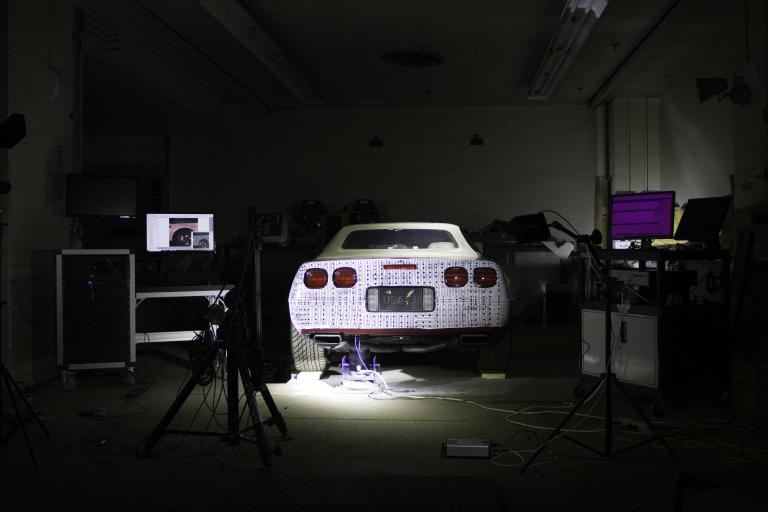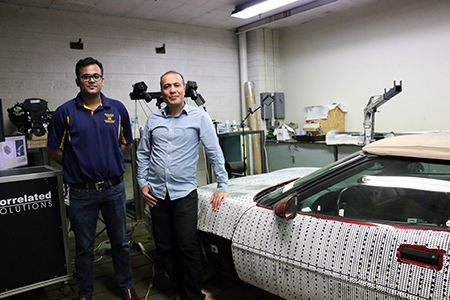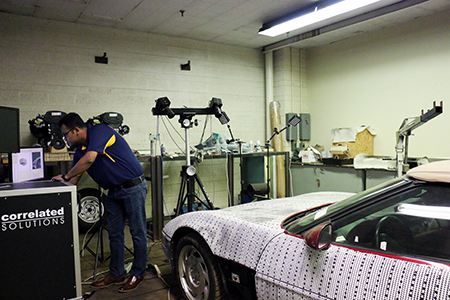
Kettering University faculty and graduate students have developed a new, more efficient way to view how a vehicle body vibrates in order to help create better body designs in the future.
Dr. Javad Baqersad, Mechanical Engineering faculty member, in partnership with graduate students, is using a pair of high-speed cameras to measure noise and vibrations of a vehicle without adding sensors to the body in a way that gives a complete visual of the entire vehicle at once, something that has never been done before, he said.

Baqersad and the graduate students use Digital Image Correlation (DIC) technology to process images and formulate a result. DIC is a 3D, non-contact optical technique to measure contour, deformation, vibration and strain on almost any material.
“When you use camera system of usually two cameras you can only see some part of a structure. There is a limited field of view. We use a method to stitch the dynamics photos together and find mode shapes of the structure - the shapes of the structure and its resonance. When you want to measure the vibrations you can apply this method. You can optimize your design and geometry so we have less vibrations. Recent developments have spurred widespread interest in producing vehicles with improved NVH performance,” Baqersad said. “The main idea was how to dynamically stitch those shapes together. Putting together to make it whole to get the full picture. If there’s somewhere we see a lot of movement we can add a joint or change the geometry to optimize the shape and decrease the noise.
“Currently none of the car manufacturers use this technique. With this technique, we will be able to use just high-speed stereo cameras and obtain the mode shape of the entire vehicle.”
The researchers started with a fender, then moved to a muffler and now use a donated Corvette to get a full vehicle picture. To determine the amount of vibration and movement of each panel, the team first placed track points or a speckled pattern on the Corvette. Using a reference photo the data processing software is able to measure movement and vibration.
The vibration characteristics of a structure are conventionally obtained by exciting the structure using an impact hammer or a mechanical shaker and measuring the response using accelerometers. However, using accelerometers for vibration measurement may induce mass loading effects and does not provide the full-field response of the structure. DIC has provided a solution because it provided the full-field response of the structure, is a non-contacting technique and does not induce any mass loading effects.
The mode shape of every field of view is then obtained based on the excitation force and measured response using the digital signal processing theory. The mode shapes of individual fields of view are stitched using a minimum of three reference points in the region common to the adjacent field of view to obtain the mode shapes of the entire structure.
Baqersad has contacted General Motors to see if they can apply their method within the company, and he is in the process of patenting the process. So far, three professional papers have been published on this project, and there are more in the works. 
Vanshaj Srivastava ‘18, a graduate student working toward his master’s in Automotive Systems at Kettering, has been working on the project for a year and a half.
“It’s a totally new thing I’m working on. It’s really interesting to see that various parameters and deflection patterns we get for each vehicle body panels. We are moving toward a more innovative approach,” Srivastava said. “It’s really exciting to work on something that's still being accepted in the industry.”
Srivastava, an international student from India, studied automotive design engineering as an undergraduate. Coming to Kettering for his graduate studies made sense for him and what he wanted to do with his career.
“The University already had a really big name in the auto industry. Kettering has the best facility and an elite group of professors which attracted me right away,” he said, adding he’s had opportunities to work on unique techniques like this project. “Currently in industry people are using the non-contact technique, but they can’t form a full picture. This is another approach that is more robust and precise and takes less time to get a precise picture.
“This can really help design teams to make design better. My favorite part was getting to work with a GM Corvette. It’s really rare to work on a sports vehicle. Getting hands-on full vehicle analysis was quite a good experience.”